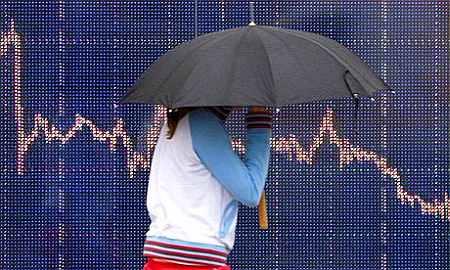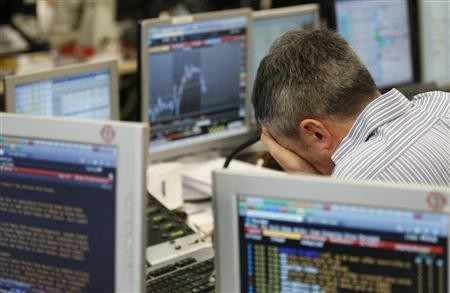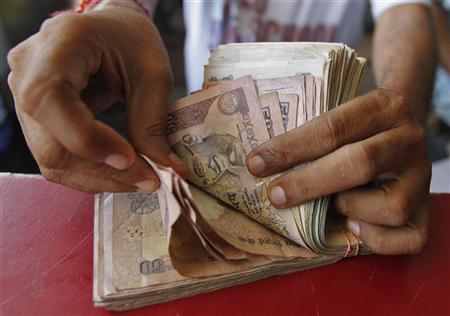Photographs: Toby Melville/Reuters Suresh Sadagopan
Inflation has been a menace for over three years now. Stocks markets have gone nowhere in this period, with the possibility of a further downslide, due to worsening economic fundamentals and the debt overhang in Europe.
Investors are now tired of waiting for returns from equities. Some have started believing in debt more than they did before. While others opine that they would have been better off in fixed deposits than equities.
But, equities perform over the long term. Though the definition of long term is also changing as in the past 3-5 years equities have given negative returns. And we don't know when will we see an uptrend.
...
How to build debt portfolio in uncertain markets
Photographs: Reuters
Hence, risk-averse and those wanting to play safe, can invest in debt products as it can help tide over uncertainties. Reason: The rate of returns being offered by fixed income instruments have peaked and there are quite a few viable options for constructing a good fixed income portfolio. Add to that their tax efficiency.
For instance, Fixed Maturity Plans (FMPs) are offering between 9 and 9.5 per cent for 1-3 years. And inspite of a benign tax treatment, these give good returns. Capital gains taxes beyond one year is 10 per cent without indexation and 20 per cent with it. Due to this, the net returns are estimated to be between 8.8 and 9.2 per cent. And that is not bad.
FMPs invest in papers that ensure the returns don't vary from the coupon rates of the underlying instruments, irrespective of changes in the interest rate cycle. Typically, those in the high tax bracket are advised FMPs.
...
How to build debt portfolio in uncertain markets
Photographs: Reuters
Another avenue is debt mutual funds. These offer coupon rates of the underlying instruments, help in capital appreciation. When interest rates move down, the underlying instruments have higher coupon rates than the prevailing rate, would rise in value.
This means an increase in the net asset value (NAV) of debt funds, which hold such instruments. Hence debt funds have the potential to offer double digit post-tax returns, in a falling rate scenario. The funds which hold comparatively longer tenures could offer higher capital appreciation.
Amongst debt funds some are dynamically managed, where the duration and instruments are decided by fund managers, who churn the portfolio as per market conditions while some follow a buy and hold strategy. Funds which hold gilts could be volatile, but can offer returns in a falling rate market.
...
How to build debt portfolio in uncertain markets
Photographs: Amit Dave/Reuters
Those looking to invest for a year could look at funds that invest in ultra short term, short term papers. Depending on the tenure these may invest in corporate bonds, certificate of deposits (CDs) of up to one year (CDs of one year tenure are yielding about 10 per cent) and short term commercial paper (CP).
These funds can yield attractive returns, even for less than a year. These funds give steady returns when the markets aren't doing well.
Shorter tenure funds (less than one year) are ultra short-term ones. Such funds invest in very short tenures instruments.
Since 3-month CD is offering 9.85 per cent and 3 month CP 10.15 per cent, ultra short-term funds would be able to offer attractive returns.
...
How to build debt portfolio in uncertain markets
Photographs: Dominic Xavier/Rediff.com
If you have less than a year in hand, opt for the dividend option (where dividend distribution tax is paid by the fund house), the investor is taxed as per the tax slab in growth option.
Tax free bonds which came up last year are long-tenure instruments of 10-15 years, yielding 8.2-8.3 per cent over the years. These are attractive over the long-term. These are better than Public Provident Fund (PPF), as the returns are assured.
PPF returns are market-linked and can change every year (has given as high as 9.5 per cent and as low as 8 per cent). Those who haven't invested in these bonds till now can buy them from the stock exchange, at an yield of 8 per cent.
...
How to build debt portfolio in uncertain markets
Photographs: Uttam Ghosh/Rediff.com
Some of the favourites with Indian investors are bank deposits and PPF. Fixed deposits are a favourite primarily due to the low risk associated with it. A one to three year deposit today is offering 8-9 per cent returns (pre-tax).
There are also company deposits which could offer 1-2 per cent more varying across companies. But they are somewhat higher on the risk measure and the investor is advised to look at the rating assigned to the offering before investing.
Triple A indicates highest level of safety and AA+ indicates a very good level of safety for return of principal and for receiving interest.PPF offers tax-free returns of 8.6 per cent.
...
How to build debt portfolio in uncertain markets
Photographs: Uttam Ghosh/Rediff.com
But PPF is a long-term instrument (15 years) and liquidity is constrained. One can invest up to 1 lakh in a financial year, which offers good savings potential for the family.
Investment portfolios can be constructed using these instruments as per specific requirements of investors.
There is also the comfort that this is going to yield a decent positive return, irrespective of what happens to our stock markets, our economy and the global economy.
The writer is a certified financial planner.









article